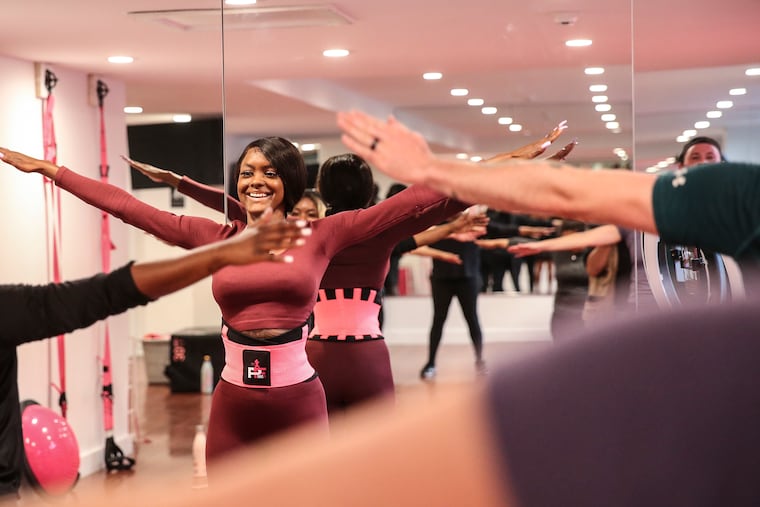Philly gyms are filling up again, as owners say their members are sick of working out at home
“It’s the desire for social interaction and that camaraderie,” one expert said, as well as a new prioritization of mental and physical wellness.

Noel Davis opened her Old City fitness studio two months before the pandemic struck. Then, she shuttered the space for more than a year as restrictions took hold and few were comfortable with group workouts.
The personal trainer and fitness instructor had to pivot to keep her fledgling business afloat, so she began offering a variety of virtual classes.
When her studio reopened in September, folks started trickling back in, and now she has almost as many clients as she had in those first months of 2020.
“It’s finally starting to get back,” Davis said. “People really want to work out now.”
And they want to do so at gyms and fitness studios.
Across the Philadelphia region, many gym owners say they feel they have weathered the brunt of the storm. They report that their memberships have rebounded to nearly pre-pandemic levels, and clients are returning, often with even more vigor and motivation.
While COVID-19 cases are rising across the region, all restrictions have been lifted, and public fatigue around precautions such as masking remains. Like all business owners, those who operate gyms and fitness studios must decide for themselves whether to require masks or proof of vaccination. Many have opted not to do so.
“Some are saying a lot of members come back and it’s just business as usual. Some are wearing masks, because that’s what’s comfortable for them,” said Josh Leve, founder and CEO of Association of Fitness Studios. Regardless, “it’s the desire for social interaction and that camaraderie.”
While about a quarter of gyms and fitness studios nationwide didn’t survive the pandemic, he said, the ones that did are now reaping the benefits of their tenacity and flexibility.
The pandemic was poised to upend the fitness industry from the start. The initial shutdown closed gyms for months, and when they reopened, restrictions were in place and the public often remained wary.
Some never returned to the gym, having found home workouts more comfortable and convenient or having invested in expensive equipment, such as Peloton bikes.
Others came back slowly, sometimes opting for outdoor or virtual classes now offered by many facilities.
For many, their motivation changed, too. More people, several gym owners said, now say they want to work out for their overall mental and physical health, the importance of which was magnified by COVID-19.
“I rarely hear, ‘I want to look like this,’” Davis said. “More people were into a summer body two years ago.”
At the spinning studio Revel Ride in Southwest Center City, owner Jamie Promislo said she lost members who got their own bikes at home. But in the last month, she said, more and more of those people seem to have developed an itch to return to group classes.
“We are starting to see more of the people who bought bikes say: ‘We’re using it as a coat rack. I can’t work out at home anymore,’” Promislo said.
So far, Revel Ride, which requires proof of vaccination, has about three-quarters of the members it had pre-COVID, she said, and each week some classes have wait lists, which Promislo uses as a barometer of whether the studio is doing well.
The energy is also up, she added: “People are even more appreciative of being there than they were before COVID.”
Such gratitude is on display regularly at Maleek Jackson Fitness Boxing Gym in Northern Liberties. The gym is growing, Jackson said.
“People wanted a social and human connection” as society reopened, Jackson said. “People are ready to hit the gym with light restrictions to let out their frustration.”
Business is “booming,” too, at the Gym by Brandon RaSean, which switched from group boot-camp classes to personal training in September 2020.
“It was scary, but what are you going do?” RaSean said. “You just have to pivot.”
It took a while to gain clients, he said. But once people began making New Year’s resolutions in January 2021, membership requests poured in, he said, with about a dozen new people signing up a week.
Some of his clients have gained weight over the pandemic, he said, and the age range now skews younger. Many wanted more of a personal experience, he said, and felt safer in the more intimate environment in Spring Garden than a big-box gym.
But even Planet Fitness has experienced gains. As of late March, the national chain reported more than 16.2 million members, its highest ever.
Meanwhile at Bodyrock Bootcamp and Executive Training in Powelton, founder Nate Mcintyre is betting on people wanting to continue some combination of at-home exercise and workouts at gyms.
“Imagine you’re finishing a terrible day of work, and you’re on your way to the gym and stuck in traffic, 20 minutes from the gym and five minutes from home,” Mcintyre said. In those cases, he said, people can log on to classes virtually and use the Crossfit “gym in a bag” that Mcintyre created to give his clients more flexibility.
At Royal Fitness in Barrington, Camden County, the return to the gym is part of a renewed interest in wellness.
“They want to not only be fit, but they want to be healthy,” fitness director Danielle Zacamy said. “More and more people are zoned into that after going through a pandemic and maybe losing someone or getting ill themselves and maybe experiencing some residual effects.”
“I think this really scared people,” she added.